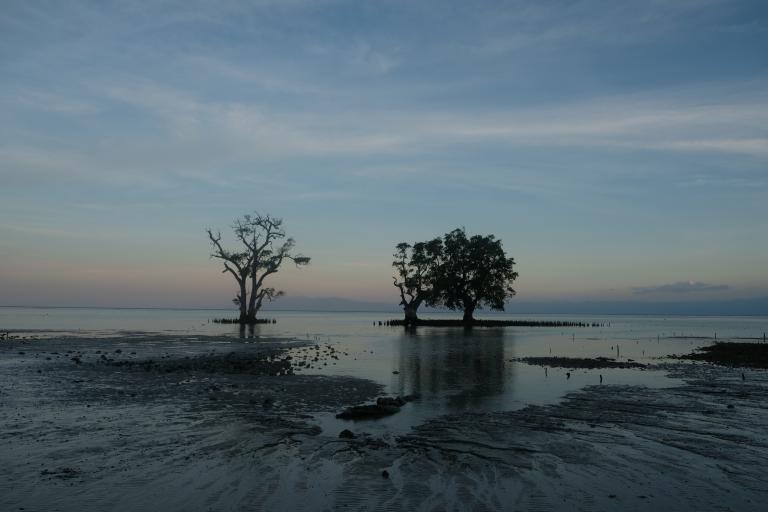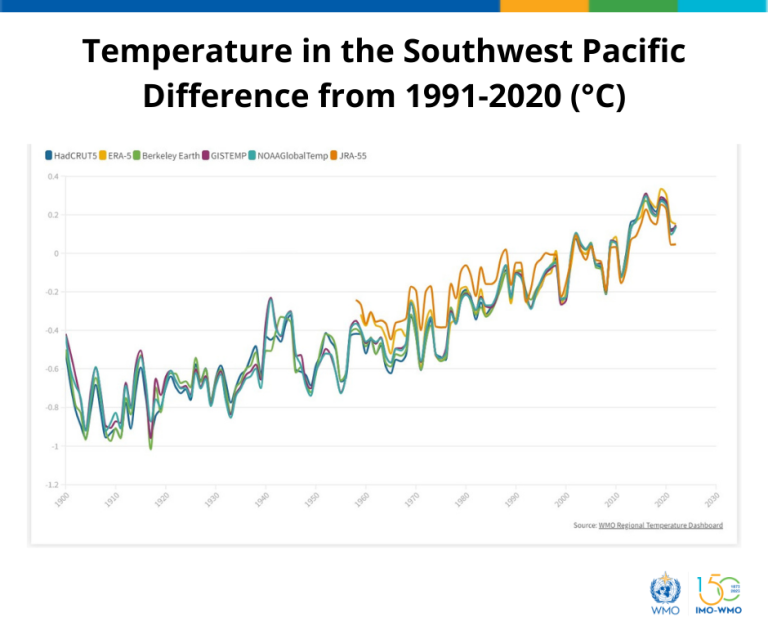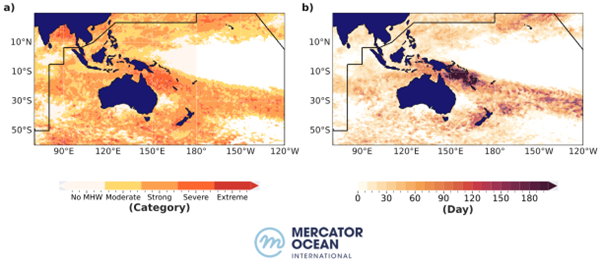Climate change impacts increase in the South-West Pacific
Fiji, 18 August 2023 (WMO) – Weather-related disasters and climate change impacts are unravelling the fabric of society in the South-West Pacific. Sea level rise threatens the future of low-lying islands whilst increasing ocean heat and acidification harms vital and vulnerable marine ecosystems, according to a new report from the World Meteorological Organization (WMO).
- Sea level rise increases more than global average
- Ocean heat and acidification threatens ecosystems and way of life
- Glacier ice thickness in the western part of the Indonesian island of New Guinea shows a big reduction
- La Niña marked only a temporary brake on rising temperature
- Agriculture especially vulnerable to climate impacts
- Early Warnings must reach everyone

The State of the Climate in the South-West Pacific 2022 report provides a snapshot of climate indicators including temperatures, sea level rise, ocean heat and acidification, and extreme weather events in 2022. It also highlights the socio-economic risks and impacts on key sectors like agriculture.
The report, along with an interactive story map, is one of a series of five regional reports and a global report from WMO providing the latest climate insights to inform decision-making.
The three-year-long La Niña event had a clear influence on temperatures in 2022. But despite its temporary cooling influence, it was still a warm year for the region. The mean temperature in 2022 was 0.2 °C to 0.3 °C higher than during the last strong La Niña event in 2011.

“The El Niño, which followed three years of La Niña conditions, is very likely to continue during the rest of the year. This will have a big impact on the South-West Pacific region as it is frequently associated with higher temperatures, disruptive weather patterns and more marine heatwaves and coral bleaching,” said WMO Secretary-General Prof. Petteri Taalas.
Compared to 2021, the number of reported disaster events decreased; however, economic losses increased. Economic damage due to flooding was US$ 8.5 billion, almost triple compared to the previous year, with most of the damage attributable to a series of flooding events in Australia. Tropical Storms Megi and Nalgae caused devastating flooding in the Philippines.
“Early warning is one of the most effective ways of reducing damage from disasters, as it empowers people to make risk-informed decisions for food security, as well as other sectors,” said Prof. Taalas.
“Despite continuous efforts to strengthen multi-hazard early warning systems, the present report clearly shows that there are still significant gaps to be addressed,” he said.
“The Early Warnings for All initiative … is critical in the Pacific, which is characterized by distinct disaster risk hotspots that are intensifying and expanding as climate-related hydrometeorological disasters intensify,” said Armida Salsiah Alisjahbana, Under-Secretary-General of the United Nations and Executive Secretary of the Economic and Social Commission for Asia Pacific.
“ESCAP and WMO, working in partnership, will continue to invest in raising climate ambition and accelerating the implementation of policy actions, which includes bringing early warnings to all in the region so that no one is left behind as our climate change crisis continues to evolve,” she said.
The report shows how the agriculture sector is one of the most critical sectors affected by climate-related disasters, echoing the national adaptation plans of many countries in the South-West Pacific. Enhancing the resilience of food systems is therefore a high priority.
Blue Pacific
The report was released at the Third Pacific Ministerial Meeting on Meteorology (PMMM-3) and the First Development Partners and Donors Engagement Meeting in Fiji. The meetings, which are all interlinked, will be guided by the theme: “Sustaining Weather, Climate, Water and Ocean Services for a Resilient Blue Pacific.
The meetings gather Government Ministers, representatives from National Meteorological and Hydrological Services (NMHSs) in the Pacific, as well as those from development partners such as the Secretariat of the Pacific Regional Environment Programme (SPREP), WMO and the private sector, to strengthen climate and weather services in the Pacific.
“Our Pacific people are at the forefront of the impact of the triple planetary crises of climate change, biodiversity loss, and pollution. Our Pacific leaders have already declared a climate emergency, reaffirming that this is now the single greatest existential threat facing the Blue Pacific,” said SPREP’s Director-General Sefanaia Nawadra.

The WMO report says that sea-level rise rates were, in general, slightly higher than the global mean rate, reaching approximately 4 mm per year in several areas.
Despite La Niña conditions, marine heatwaves occurred in various parts of the region. The most prominent and persistent marine heatwaves occurred in a large area north-east of Australia and south of Papua New Guinea in the Solomon and Coral Seas, over a period of more than six months.
The ocean has taken up more than 90% of the excess heat in the climate system. Ocean warming contributes about 40% of the observed global mean sea-level rise through thermal expansion of seawater. It is altering ocean currents, indirectly altering storm tracks and affecting marine ecosystems.
Most of the regions in the South-West Pacific show upper-ocean (0–700 m) warming since 1993. Warming is particularly strong, with rates exceeding 2–3 times the global average warming rates, in the Solomon Sea and east of the Solomon Islands; in the Arafura, Banda and Timor Seas; east of the Philippines; along the southern coast of Indonesia and in the Tasman Sea, according to the report.
In Indonesia, satellite estimates of the area of a glacier in the western part of the island of New Guinea showed a total ice area in April 2022 of 0.23 km2, a decrease of about 15% from the previous assessment of 0.27 km2 in July 2021. From 2016 to 2022, the average reduction in ice area was approximately 0.07 km2 per year. Measurements of ice thickness via a single stake show a reduction in thickness of 24 m from June 2010 to the beginning of 2021, and the estimated remaining ice thickness in December 2022 was just 6 meters.
Climate-related impacts and risks

La Niña conditions contributed to significant rainfall anomalies in the region. Most of the equatorial Pacific islands experienced drier-than-normal conditions, and Kiribati and Tuvalu suffered from significant water shortages at times during the year. At the other extreme, Australia suffered significant economic loss in association with severe floods.
In 2022, a total of 35 natural hazard events were reported in the South-West Pacific according to the International Disaster Database (EM-DAT), of which over 70% were flood events. These resulted in over 700 fatalities, of which over 70% were associated with storms.
Over 8 million people were directly affected by these hazards, and they caused total economic damage of close to US$ 9 billion. Storms were the leading cause of death and affected the greatest number of people in 2022, especially in the Philippines and Fiji.
A comparison of the economic losses from disasters in the South-West Pacific region in 2022 with the average over the past 20 years (2002–2021) shows that the losses associated with flooding in 2022 (an estimated US$ 8.5 billion) were more than 4 times the average.
In 2022, as an aggregate, flooding caused the highest economic losses in Australia, where the total was over US$ 8 billion, followed by Indonesia (over US$ 74 million) and the Philippines (over US$ 11 million).

WMO wishes to thank National Meteorological and Hydrological Services, partner organizations and the network of individual experts who contributed to this report.
The World Meteorological Organization (WMO) is a specialized agency of the United Nations responsible for promoting international cooperation in atmospheric science and meteorology.
WMO monitors weather, climate, and water resources and provides support to its Members in forecasting and disaster mitigation. The organization is committed to advancing scientific knowledge and improving public safety and well-being through its work.
For further information, please contact:
- Clare Nullis WMO media officer cnullis@wmo.int +41 79 709 13 97
- Region:
- Region V: South-West Pacific

